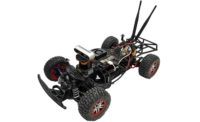Autonomous Tandem Drift Sequence Improves Vehicle Safety

Photo courtesy Toyota Research Institute
LOS ALTOS, CA—Engineers at the Toyota Research Institute (TRI) and Stanford University recently drifted two autonomous vehicles in tandem. The experiment was conducted at Thunderhill Raceway Park in Willows, CA, using a pair of modified Toyota GR Supra sports cars. Algorithms on the lead car were developed at TRI, while Stanford engineers developed those on the chase car.
Drifting refers to a motorsports maneuver where a driver precisely controls a vehicle’s direction after breaking traction by spinning the rear tires—a skill transferable to recovering from a slide on snow or ice. By adding a second car drifting in tandem, the engineers simulated dynamic conditions where cars must respond quickly to other vehicles, pedestrians and cyclists.
TRI engineers focused on developing robust and stable control mechanisms for the lead car, allowing it to make repeatable, safe lead runs. Stanford engineers developed artificial intelligence-based models and algorithms that enabled the chase car to adapt dynamically to the motion of the lead car so that it could drift alongside without colliding. By leveraging AI to constantly train the neural network using data from previous tests, the vehicles improved from every trip to the track.
“Our researchers came together with one goal in mind—how to make driving safer,” says Avinash Balachandran, Ph.D., vice president of TRI’s Human Interactive Driving division. “Now, utilizing the latest tools in AI, we can drift two cars in tandem autonomously.
“It is the most complex maneuver in motorsports, and reaching this milestone with autonomy means we can control cars dynamically at the extremes,” claims Balachandran. “This has far-reaching implications for building advanced safety systems into future automobiles.”
“The physics of drifting are actually similar to what a car might experience on snow or ice,” adds Chris Gerdes, Ph.D., a professor of mechanical engineering and co-director of the Center for Automotive Research at Stanford. “What we have learned from this autonomous drifting project has already led to new techniques for controlling automated vehicles safely on ice.”
In an autonomous tandem drifting sequence, two vehicles—a lead car and a chase car—navigate a course at times within inches of each other while operating at the edge of control. The engineers used state-of-the-art techniques to build the vehicle’s AI, including a neural network tire model that allowed it to learn from experience, much like an expert driver.
According to Balachandran, many car crashes are due to a loss of vehicle control in sudden, dynamic situations. “When your car begins to skid or slide, you rely solely on your driving skills to avoid colliding with another vehicle, tree or obstacle,” he explains.
“An average driver struggles to manage these extreme circumstances, and a split second can mean the difference between life and death,” says Balachandran. “This new technology can kick in precisely in time to safeguard a driver and manage a loss of control, just as an expert drifter would.”
Looking for a reprint of this article?
From high-res PDFs to custom plaques, order your copy today!







